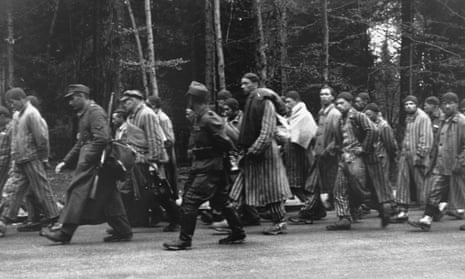The concentration camp at Dachau is often represented as a model of its kind. Thus the “Münchener Illustrierte Presse” of July 16 described it (with illustrations) as a kind of institute where politically misguided men are being trained to become good citizens. They are seen drilling and working in a way that suggests a healthy and a disciplined but not overstrenuous life. The truth is that this camp is in no sense a model, although it is no worse than many of the Hitlerite concentration camps. The following details of the organisation and routine have come into the possession of your correspondent:-
The number of prisoners (according to the September list) is 2,200-2,400. Of these about fifty are intellectuals, a few are members of the middle class without any political affiliations, fifty or sixty are Nazis, about sixty are Jews, about five hundred are Socialists, two are army officers (Catholics and members of the Bavarian People’s party), there are several beggars and ordinary criminals, fifteen are non-German subjects, and the remainder are Communists. The overwhelming majority belong to the working class.
The prisoners are housed in ten barracks. Each squad has two tubs, six wash-basins, and two pails (flowing water is available, but the swimming-bath shown in the “Münchener Illustrierte Presse” is for the use of the Nazi guards only).
All officials of the Communist party who refuse to give the political information the Nazis demand are sent to the cells (“Arrestzellen”). So are the prisoners who have committed offences such as making political remarks in their letters. The cells are of concrete, they have one barred window each (which can be darkened), they are damp, and without heating arrangements. In September twenty-one new cells were built by the prisoners. Chains (with manacles - made by the prisoners in the camp forge - for wrists and ankles) are let into the walls. The sleeping accommodation consists of wooden planks without a blanket. A prisoner sentenced to detention (“Arrest”) in one of these cells gets nothing to eat on the first day, then bread and water for three days, and a hot meal every fourth day. Those sentenced to “Mittelarrest,” a milder form of detention, are allowed a straw sack to sleep on, while their cells are not darkened. Prisoners may be sentenced to detention for as much as three months.
Besides detention in the cells there is corporal punishment. This consists of flogging with an ox-hide thong that has a strip of steel, three or four millimetres wide, running along its whole length (these are made by the prisoners). The blows - the number varies from twenty-five to seventy-five according to the sentence - are counted out by an S.S. man. Two other S.S. men hold the prisoner down, one by the hands and the other by the head, round which a sack is wrapped so that the prisoner’s cries are stifled.
Officials of the Socialist and Communist parties are usually beaten on arrival, without having committed any specific offence. Prisoners are sentenced to corporal punishment for very small offences, such as uttering Communist slogans. On August 18 twenty-five men who had arrived on the previous day received twenty-five to seventy-five blows each on their bared bodies for no apparent reason, while their Nazi guards amused themselves with a radio set.
In addition to regular punishments there are special forms of arbitrary ill-treatment. Thus prisoners are sometimes beaten with wet towels. Sometimes they are bastinadoed until the soles of their feet are lacerated. Seven S.A. men who arrived in the camp on August 1 were bastinadoed as well as being maltreated in other ways. Two of them died of their injuries. On September 2 one of the Nazi guards broke a prisoner’s jaw with a blow of his fist. Some prisoners have also been beaten with lengths of rubber hosepipe. Some have been burnt with cigarette ends and some have been put to what Americans call the “water torture.”
Amongst the prisoners who have received severe injuries are L. Buchmann, Georg Freischütz, and a journalist named Ewald Thunig. The Munich Communist Sepp Götz was killed after being so beaten that he could no longer stand. The student Wickelmeier was killed by a bullet. The Communist Fritz Dressel was beaten to death. Leonhard Hausmann, a municipal councillor, Lehrburger, Aron (a member of the Bamberg Reichsbanner), and Stenzel were killed. Willy Franz was killed in September - he was officially reported to have hanged himself, but the post-mortem showed no traces of hanging, while the face was stained with blood and the clothes blood-sodden. At the end of November the Communist official Buerk (from Memmingen) was killed. The total number of prisoners who have been killed or who have died of their injuries at Dachau cannot be far short of fifty.
This is an edited extract, click to read on

Comments (…)
Sign in or create your Guardian account to join the discussion